power steering TOYOTA RAV4 EV 2012 1.G Owners Manual
[x] Cancel search | Manufacturer: TOYOTA, Model Year: 2012, Model line: RAV4 EV, Model: TOYOTA RAV4 EV 2012 1.GPages: 520, PDF Size: 8.29 MB
Page 2 of 520

TABLE OF CONTENTSIndex
2
1-1. EV systemCharacteristics of the EV (Electric Vehicle) system .... 26
EV (Electric Vehicle) system precautions ............ 32
Energy monitor/ consumption screen ........... 38
EV (Electric Vehicle) driving tips .......................... 41
1-2. Navigation system screen operations
Navigation system screen operations .......................... 44
1-3. Charging Charging equipment ............. 46
Power sources that can be used .............................. 50
Charging and pre-climate (Remote Climate Control)
procedures ......................... 53
When normal charging cannot be carried out ......... 88
Inspecting the charging cable .................................. 92
1-4. Key information Keys ..................................... 94 1-5. Opening, closing and
locking the doors
Smart key system ................. 96
Wireless remote control ...... 108
Side doors .......................... 110
Back door ........................... 113
1-6. Adjustable components (seats, mirrors,
steering wheel)
Front seats.......................... 118
Rear seats .......................... 121
Head restraints ................... 127
Seat belts............................ 131
Steering wheel .................... 140
Anti-glare inside rear view mirror ........................ 141
Outside rear view mirrors ... 143
1-7. Opening and closing the windows
Power windows................... 146
1-8. Theft deterrent system Immobilizer system ............. 149
Theft prevention labels ....... 151
1-9. Safety information Correct driving posture ....... 152
SRS airbags ....................... 154
Front passenger occupant classification system ......... 166
Child restraint systems ....... 172
Installing child restraints ..... 176
1Before driving
Page 25 of 520
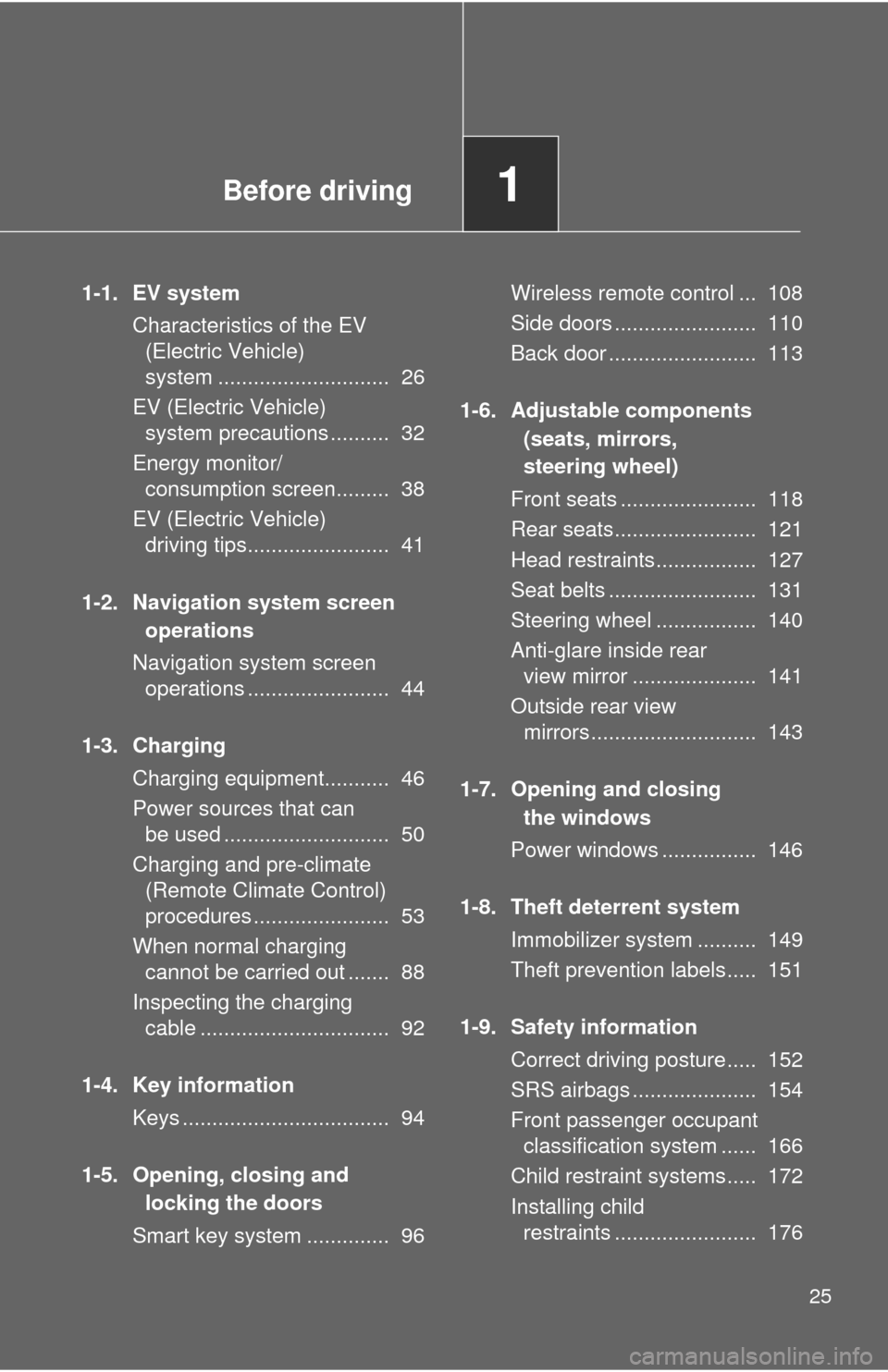
Before driving1
25
1-1. EV systemCharacteristics of the EV (Electric Vehicle)
system ............................. 26
EV (Electric Vehicle) system precautions .......... 32
Energy monitor/ consumption screen......... 38
EV (Electric Vehicle) driving tips........................ 41
1-2. Navigation system screen operations
Navigation system screen operations ........................ 44
1-3. Charging Charging equipment........... 46
Power sources that can be used ............................ 50
Charging and pre-climate (Remote Climate Control)
procedures ....................... 53
When normal charging cannot be carried out ....... 88
Inspecting the charging cable ................................ 92
1-4. Key information Keys ................................... 94
1-5. Opening, closing and locking the doors
Smart key system .............. 96 Wireless remote control ... 108
Side doors ........................ 110
Back door ......................... 113
1-6. Adjustable components (seats, mirrors,
steering wheel)
Front seats ....................... 118
Rear seats........................ 121
Head restraints................. 127
Seat belts ......................... 131
Steering wheel ................. 140
Anti-glare inside rear view mirror ..................... 141
Outside rear view mirrors............................ 143
1-7. Opening and closing the windows
Power windows ................ 146
1-8. Theft deterrent system Immobilizer system .......... 149
Theft prevention labels..... 151
1-9. Safety information Correct driving posture..... 152
SRS airbags ..................... 154
Front passenger occupant classification system ...... 166
Child restraint systems..... 172
Installing child restraints ........................ 176
Page 141 of 520
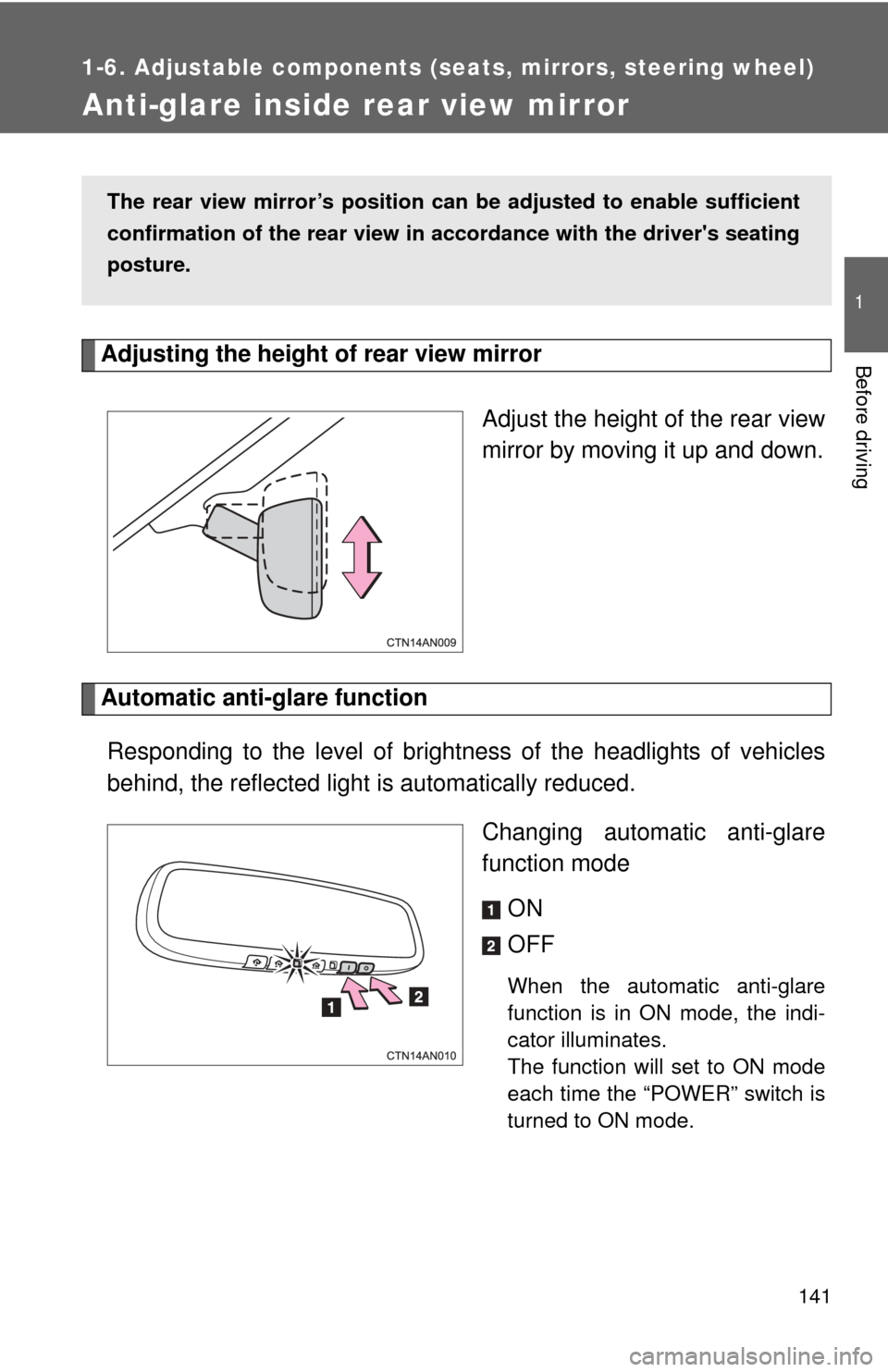
141
1
1-6. Adjustable components (seats, mirrors, steering wheel)
Before driving
Anti-glare inside rear view mirror
Adjusting the height of rear view mirrorAdjust the height of the rear view
mirror by moving it up and down.
Automatic anti-glare functionResponding to the level of brightness of the headlights of vehicles
behind, the reflected light is automatically reduced.
Changing automatic anti-glare
function modeON
OFF
When the automatic anti-glare
function is in ON mode, the indi-
cator illuminates.
The function will set to ON mode
each time the “POWER” switch is
turned to ON mode.
The rear view mirror’s position can be adjusted to enable sufficient
confirmation of the rear view in accordance with the driver's seating
posture.
Page 144 of 520
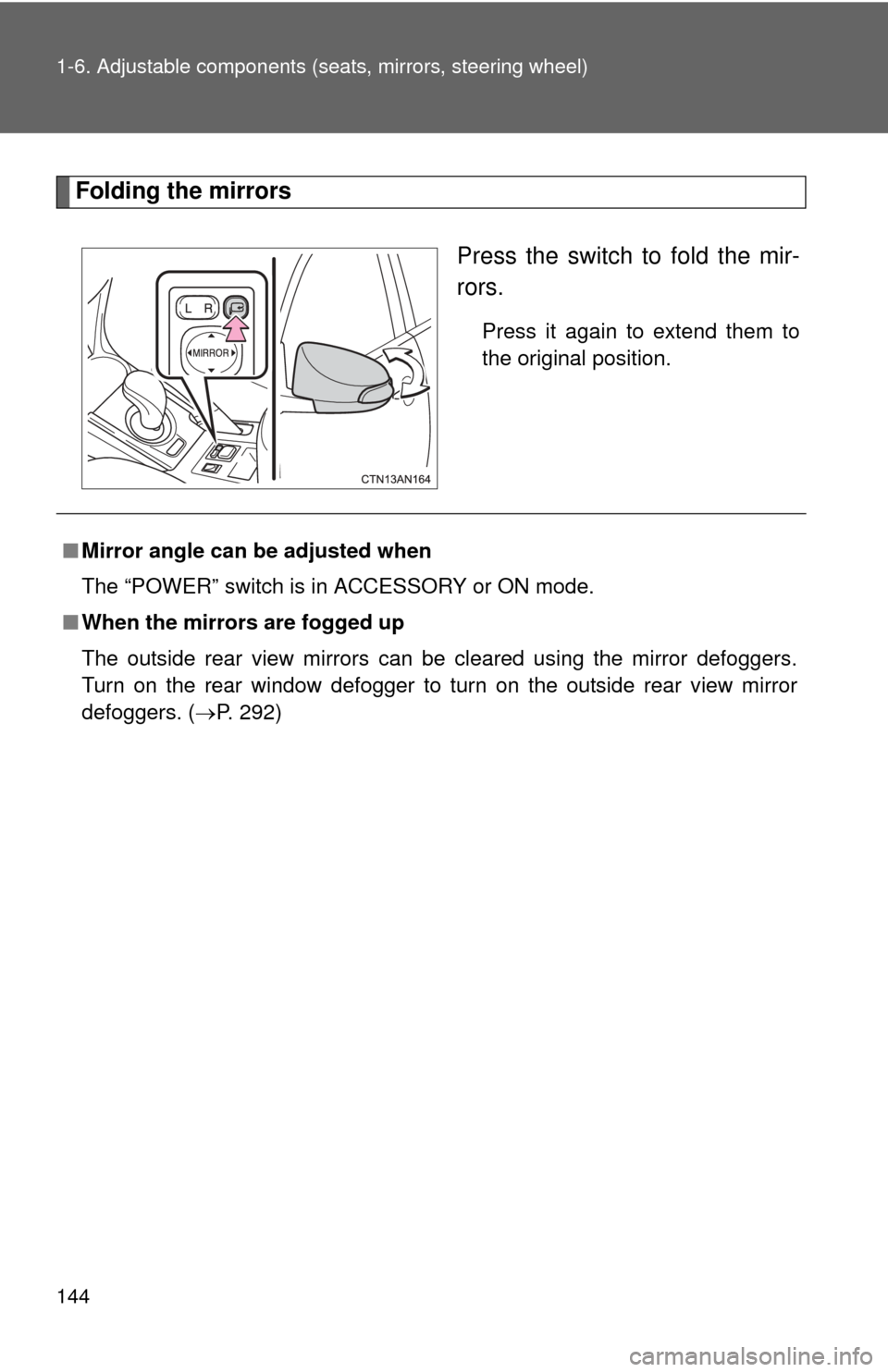
144 1-6. Adjustable components (seats, mirrors, steering wheel)
Folding the mirrors
Press the switch to fold the mir-
rors.
Press it again to extend them to
the original position.
■Mirror angle can be adjusted when
The “POWER” switch is in ACCESSORY or ON mode.
■ When the mirrors are fogged up
The outside rear view mirrors can be cleared using the mirror defoggers.
Turn on the rear window defogger to turn on the outside rear view mirror
defoggers. ( P. 292)
Page 194 of 520

194 2-1. Driving procedures
CAUTION
●Do not shift the shift position to D while the vehicle is moving backward.
Doing so can damage the transmission and may result in a loss of vehicle\
control.
● Shifting the shift position to N while the vehicle is moving will disengage
the EV system’s drive-train. Regenerative braking is not available with the
EV system disengaged and the transmission may be damaged.
● During normal driving, do not turn off the EV system. Turning the EV sys-
tem off while driving will not cause loss of steering or braking control, but
the power assist to these systems will be lost. This will make it more diffi-
cult to steer and brake, so you should pull over and stop the vehicle as
soon as it is safe to do so.
However, in the event of an emergency, such as if it becomes impossible
to stop the vehicle in the normal way: P. 479
● Use regenerative braking (shift position B instead of shift position D) to
maintain a safe speed when driving down a steep hill.
Using the brakes continuously may cause the brakes to overheat and lose
effectiveness. ( P. 207)
● Do not adjust the position of the steering wheel, the seat, or the inside or
outside rear view mirrors while driving.
Doing so may result in a loss of vehicle control that can cause accidents,
resulting in death or serious injury.
● Always check that all passengers' arms, heads or other parts of their body
are not outside the vehicle, as this may result in death or serious injury.
● Do not drive in excess of the speed limit. Even if the legal speed limit per-
mits it, do not drive over 85 mph (140 km/h) unless your vehicle has high-
speed capability tires. Driving over 85 mph (140 km/h) may result in tire
failure, loss of control and possible injury. Be sure to consult a tire dealer
to determine whether the tires on your vehicle are high-speed capability
tires or not before driving at such speeds.
Page 198 of 520

198 2-1. Driving procedures
NOTICE
■When driving the vehicle
●Do not depress the accelerator and brake pedals at the same time during
driving, as this may restrain driving torque.
● Do not use the accelerator pedal or depress the accelerator and brake
pedals together to hold the vehicle on a hill.
■ Avoiding damage to vehicle parts
●Do not turn the steering wheel fully in either direction and hold it there for
an extended period of time.
Doing so may damage the power steering motor.
● When driving over bumps in the road, drive as slowly as possible to avoid
damaging the wheels, underside of the vehicle, etc.
■ If you get a flat tire while driving
A flat or damaged tire may cause the following situations. Hold the steering
wheel firmly and gradually press the brake pedal to slow down the vehicle.
●It may be difficult to control your vehicle
● The vehicle will make abnormal sounds
● The vehicle will behave abnormally
Information on what to do in case of a flat tire ( P. 447)
Page 204 of 520
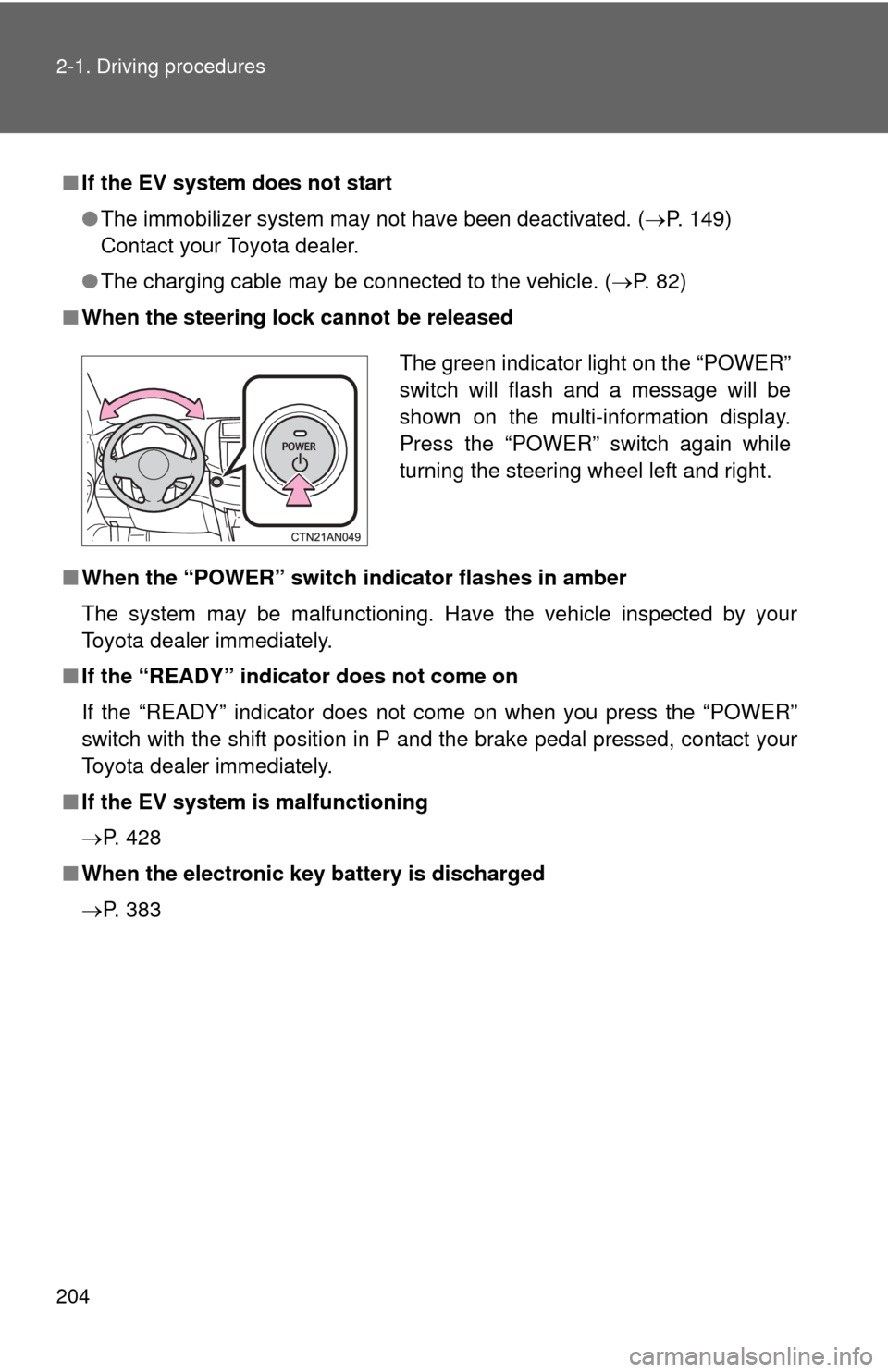
204 2-1. Driving procedures
■If the EV system does not start
●The immobilizer system may not have been deactivated. ( P. 149)
Contact your Toyota dealer.
● The charging cable may be connected to the vehicle. ( P. 82)
■ When the steering lock cannot be released
■ When the “POWER” switch in dicator flashes in amber
The system may be malfunctioning. Have the vehicle inspected by your
Toyota dealer immediately.
■ If the “READY” indicator does not come on
If the “READY” indicator does not come on when you press the “POWER”
switch with the shift position in P and the brake pedal pressed, contact your
Toyota dealer immediately.
■ If the EV system is malfunctioning
P. 428
■ When the electronic key battery is discharged
P. 383
The green indicator light on the “POWER”
switch will flash and a message will be
shown on the multi-information display.
Press the “POWER” switch again while
turning the steering wheel left and right.
Page 205 of 520

205
2-1. Driving procedures
2
When driving
CAUTION
■
When starting the EV system
Always start the EV system while sitting in the driver’s seat. Do not depress
the accelerator pedal while starting the EV system under any circumstances.
Doing so may cause an accident resulting in death or serious injury.
■ Stopping the EV system in an emergency
If you want to stop the EV system in an emergency while driving the vehi\
cle,
press and hold the “POWER” switch for more than 2 seconds, or press it
briefly 3 times or more in succession. ( P. 479)
However, do not touch the “POWER” switch while driving except in an emer-
gency. Turning the EV system off while driving will not cause loss of steering
or braking control, but the power assist to these systems will be lost. This will
make it more difficult to steer and brake, so you should pull over and stop
the vehicle as soon as it is safe to do so.
NOTICE
■ To prevent 12-volt battery discharge
Do not leave the “POWER” switch in ACCESSORY or ON mode for long
periods of time without the EV system on.
■ When starting the EV system
●Do not depress the accelerator pedal unnecessarily.
● If the EV system becomes difficult to start, have your vehicle checked by
your Toyota dealer immediately.
Page 251 of 520
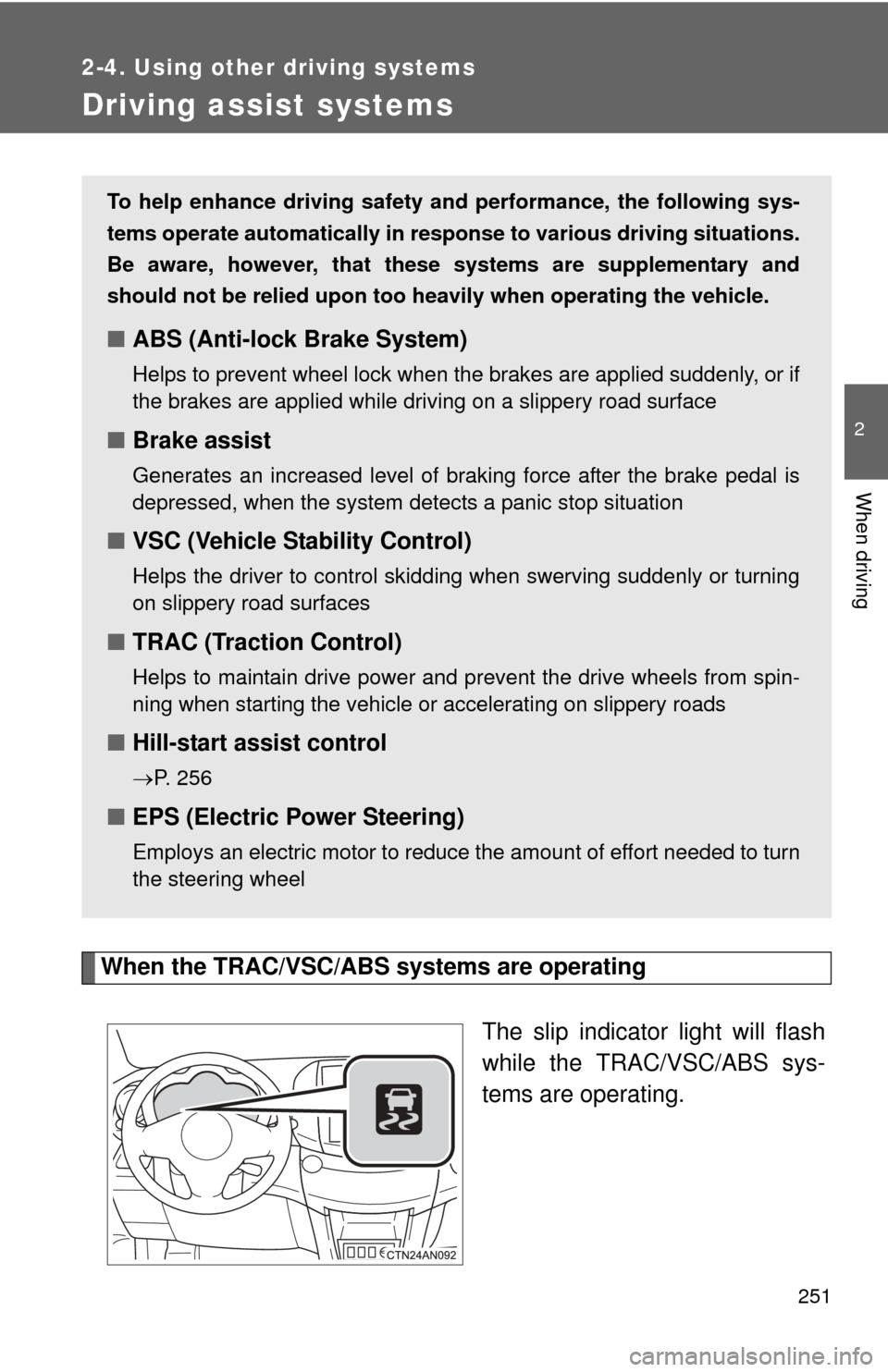
251
2-4. Using other driving systems
2
When driving
Driving assist systems
When the TRAC/VSC/ABS systems are operatingThe slip indicator light will flash
while the TRAC/VSC/ABS sys-
tems are operating.
To help enhance driving safety and performance, the following sys-
tems operate automatically in res ponse to various driving situations.
Be aware, however, that these systems are supplementary and
should not be relied upon too heavi ly when operating the vehicle.
■ABS (Anti-lock Brake System)
Helps to prevent wheel lock when the brakes are applied suddenly, or if
the brakes are applied while driving on a slippery road surface
■Brake assist
Generates an increased level of braking force after the brake pedal is
depressed, when the system detects a panic stop situation
■VSC (Vehicle Stability Control)
Helps the driver to control skidding when swerving suddenly or turning
on slippery road surfaces
■TRAC (Traction Control)
Helps to maintain drive power and prevent the drive wheels from spin-
ning when starting the vehicle or accelerating on slippery roads
■Hill-start assist control
P. 256
■EPS (Electric Power Steering)
Employs an electric motor to reduce the amount of effort needed to turn
the steering wheel
Page 390 of 520

390 4-3. Do-it-yourself maintenance
12 ABS 130 A Anti-lock brake system
13 ECB 1 50 AElectronically controlled brake sys-
tem
14 ECB 2 50 AElectronically controlled brake sys-
tem
15 W/P-IGCT 50 A P/T W/P, BATT W/P 1, BATT W/P 2
16 EPS 60 A Electric power steering
17 P/I 60 AIGCT-D, HORN, parking control
system, IG2
18 MAIN 60 AH-LP MAIN, DRL, ODS, smart key
system, ABS 2, steering lock sys-
tem, PM-B, ECU-B MAIN
19 CONTACTOR 15 A Traction battery, charging system
20 IG2 15 A Starting system
21
HORN 10 A Horn
22 IGCT-D 7.5 A Thermal control system, power
management ECU, parking control
system, multiplex communication
system
23 PM-IGCT 7.5 A Power management system
24 P CNT-IGCT 7.5 A Parking control system
25 A/C-IGCT 10 A Air conditioning system
26 FAN-IGCT 7.5 A Electric cooling fans
FuseAmpereCircuit